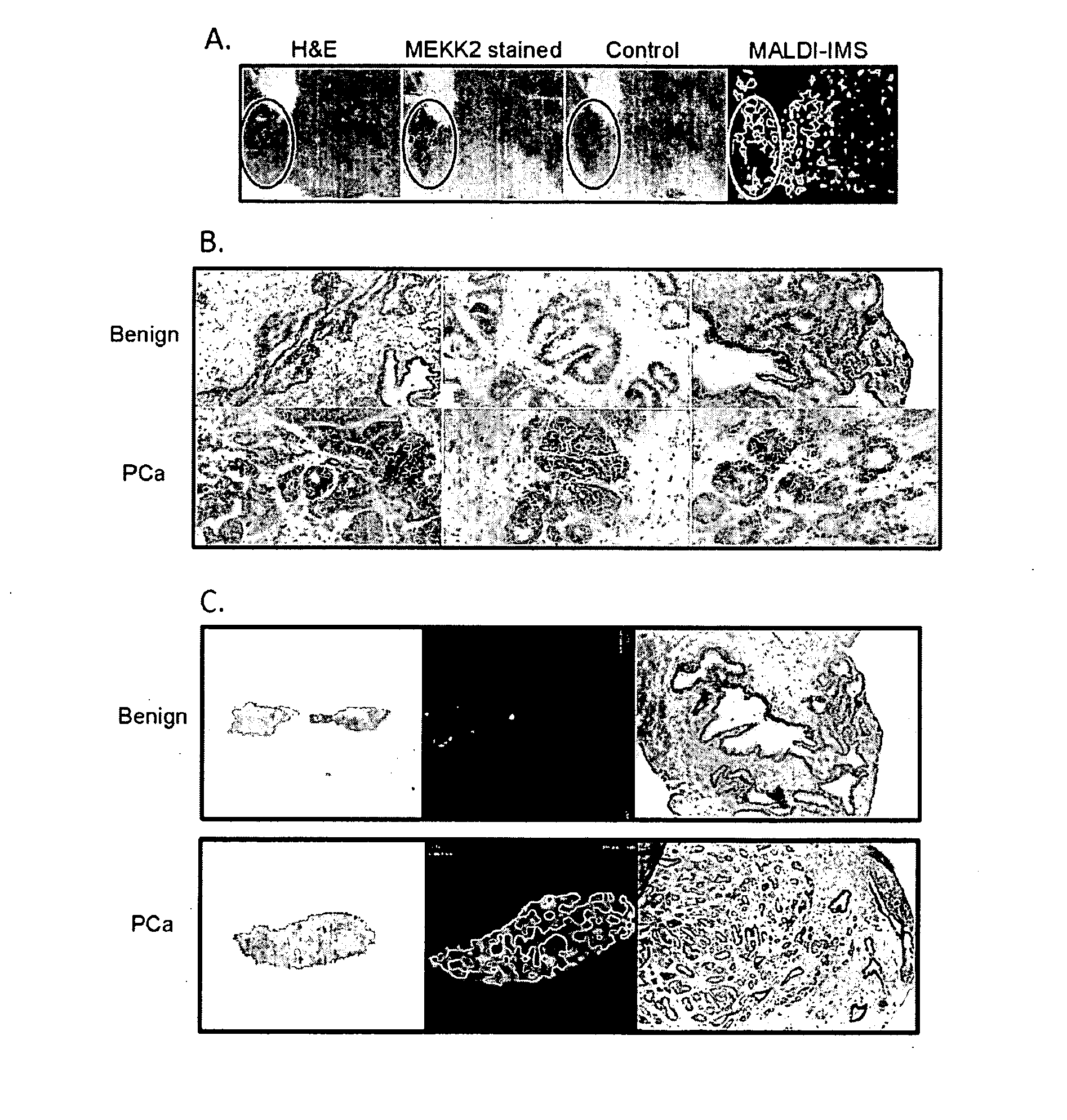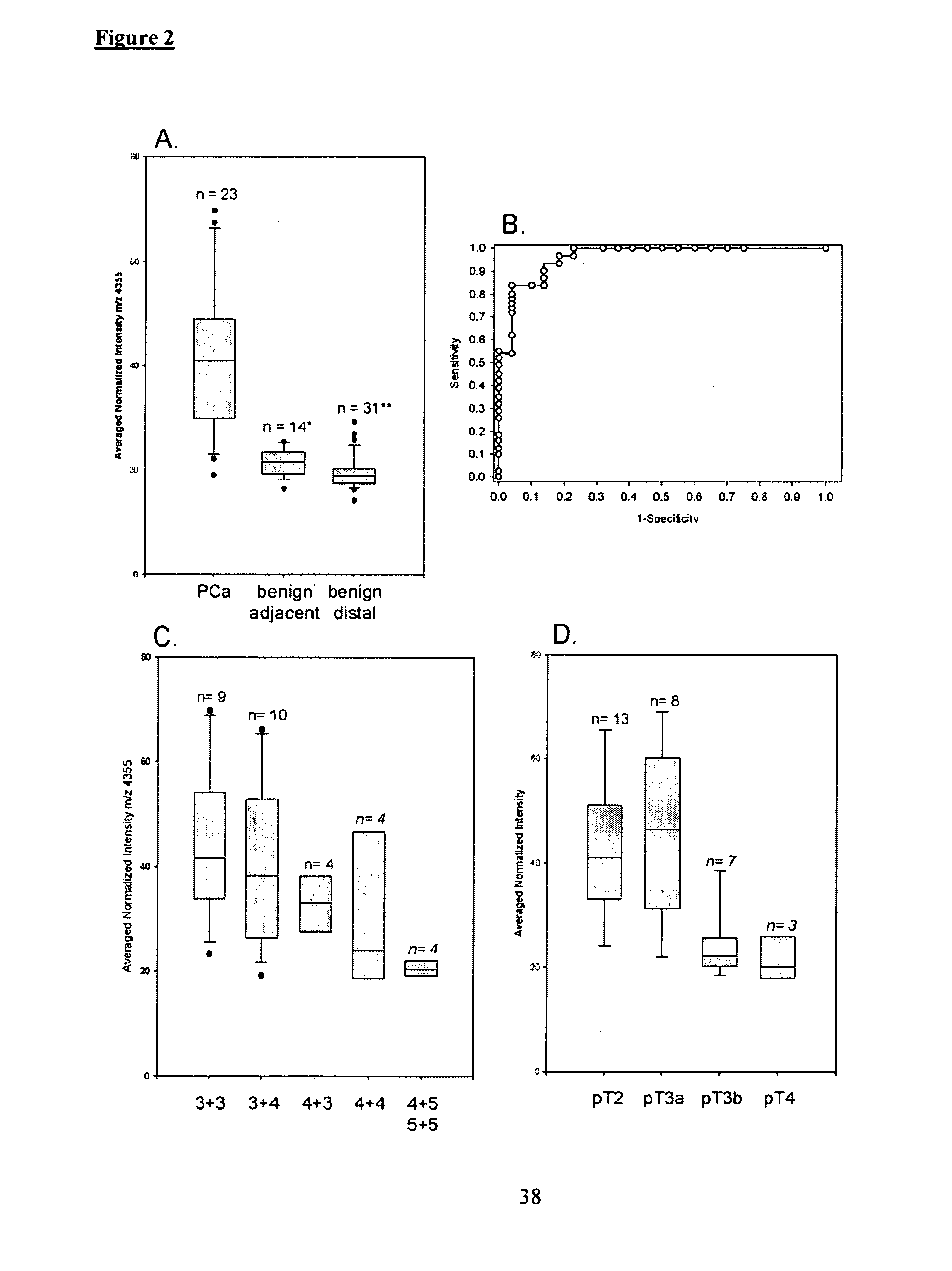Imaging Mass Spectrometry for Improved Prostrate Cancer Diagnostics
- Summary
- Abstract
- Description
- Claims
- Application Information
AI Technical Summary
Benefits of technology
Problems solved by technology
Method used
Image
Examples
example 1
Identification of Prostate Cancer Tumor-Specific Biomarkers
A. Materials and Methods
[0061]Patients and Tissue Samples. Patients were consented prior to undergoing radical prostatectomy at Sentara Norfolk General Hospital. Study protocols were approved by the institutional review board at EVMS. The age range of the patients was 46-82 with a mean age of 58.8 years. A total of 75 patients (21 for the discovery set and 54 for the validation set) were recruited for this study. Two cored specimens were harvested from each prostate immediately after removal of the gland. Each core is divided longitudinally to create mirrored cores; one was fixed and paraffin embedded and the other is embedded in OCT (optimal cutting temperature compound, Sakura Finetek USA) and frozen at 80° C. The frozen blocks yielded 41 sections (10 for the discovery set and 31 for the validation set) of benign tissue harvested from prostate tissue distal from the tumor site and 34 sections (11 for the discovery set and ...
example 2
Differential Protein Expression Using MALDI-IMS for the Detection of Metastatic Disease
[0083]Frozen prostate sections of similar stage disease were processed in which the case / control design is the discovery of metastatic disease after surgery in the case group. This study concentrated on differential expression patterns of the tumor tissue regions between case and control. From the examination of eight pairs of case / control samples, a list of top discriminating spectral peaks was generated and is presented in Table 2. Several of the markers were plotted for image generation and the images were subsequently compared to the mirrored histologically stained and pathology-read sections. FIG. 10 shows the ability to detect cancer in tumors associated with distal metastatic disease using expression of select markers.
example 3
Utilization of UMFix Treated Tissue for MALDI-IMS
[0084]The utility of the inventive biomarkers is evident at the biopsy stage. Since frozen sections are not suitable for biopsy-driven diagnostics, a pathology-friendly fixation method known as UMFix is incorporated that is acceptable to clinical histology but also able to preserve protein. The UMFix approach was developed at the University of Miami and is a commercially viable system for tissue preparation in place and is available to pathologists. The UMFix process preserves both IMS detail and information in a fixed tissue for mirrored histology. FIG. 11 is an image of the profile within the region of the 4360 m / z peak utilizing UMFix preserved tissues.
[0085]While the invention has been illustrated and described in the figures and foregoing description, the same is to be considered as illustrative and not restrictive in character, it being understood that only the preferred embodiments have been shown and described and that all cha...
PUM
 Login to View More
Login to View More Abstract
Description
Claims
Application Information
 Login to View More
Login to View More - R&D
- Intellectual Property
- Life Sciences
- Materials
- Tech Scout
- Unparalleled Data Quality
- Higher Quality Content
- 60% Fewer Hallucinations
Browse by: Latest US Patents, China's latest patents, Technical Efficacy Thesaurus, Application Domain, Technology Topic, Popular Technical Reports.
© 2025 PatSnap. All rights reserved.Legal|Privacy policy|Modern Slavery Act Transparency Statement|Sitemap|About US| Contact US: help@patsnap.com



